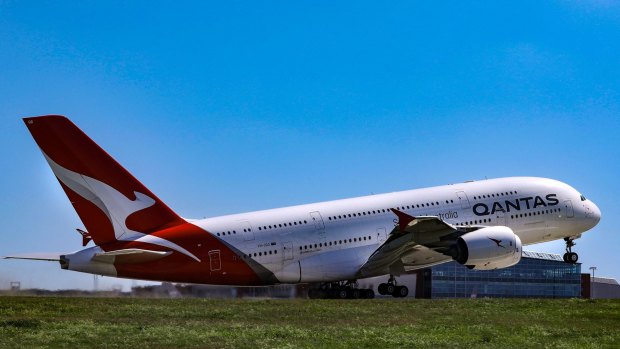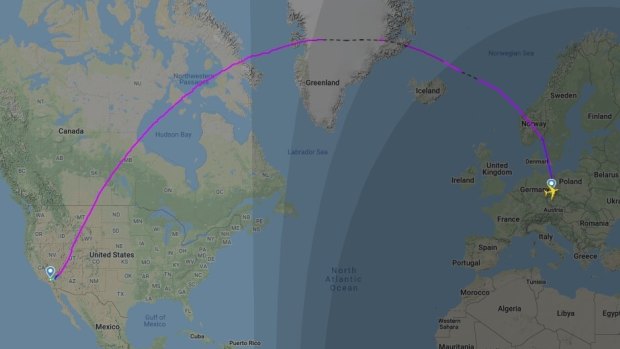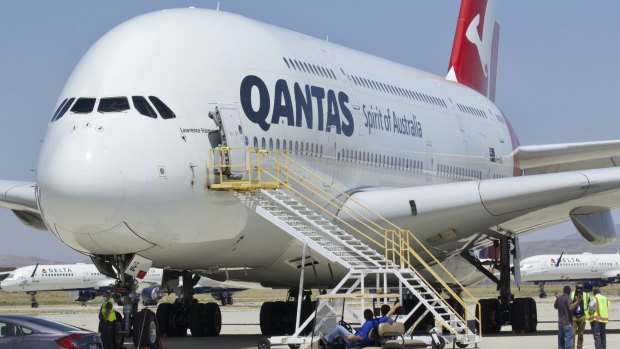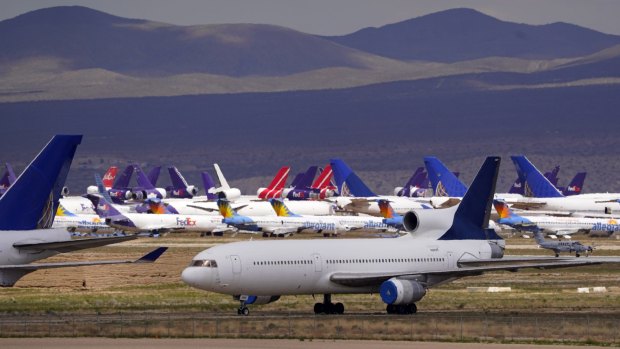This was published 3 years ago
Qantas A380: Last superjumbo makes final flight ahead of storage in Mojave desert until 2023
By Craig Platt

A Qantas A380 takes off from Dresden last month after undergoing refurbishment. Credit: Getty Images
The last Qantas A380 has made its final flight for the time being, arriving in California ahead of entering storage.
The superjumbo, registration VH-OQI, flew from Dresden, Germany, to Victorville on Monday.
From there, it travelled to the Mojave Desert, where it will be stored along with the rest of Qantas' fleet of 12 A380s until demand for international travel returns.

Flight QF6006's route from Dresden, Germany to Victorville, US. Credit: FlightRadar24.com
Qantas CEO Alan Joyce has estimated that won't happen until 2023, grounding the A380s for three years. Several Boeing 787 Dreamliners, which are also used for international long-haul routes, have also been put into storage at Mojave.
However, Qantas will use a Dreamliner next month for a sightseeing flight that will depart and land at Sydney Airport after flying over Australian icons like the Great Barrier Reef and Uluru. Qantas Dreamliners will also be used for the first time by Antarctica Flights for their annual summer sightseeing trips over Antarctica.
"The A380s have to remain on the ground for at least three years until we see those international volumes brought back," Mr Joyce said in June.

One of the Qantas A380s after arriving in Victorville in July.Credit: AP
"The aircraft are being put into the Mojave desert because it's better for them to be sitting there.
The environment protects the aircraft a lot more, and we have the intention, at the right time, to activate them."
The low humidity in deserts makes them popular for storing or retiring aircraft, as it prevents deterioration of the body and components. Qantas's Boeing 747 jumbo jets, which were retired early due to the pandemic's effect on international travel, have also ended up in Mojave (though at least one has been sold to a mystery buyer, so will fly again).

Planes in storage at Victorville, California.Credit: AP
Although there is an aircraft storage facility here in Australia, located near Alice Springs, Qantas told Traveller recently that California was a more practical solution, as the airline has A380 and Dreamliner maintenance engineers based at Los Angeles International airport, just two hours' drive away.
Why did the plane fly in from Dresden, rather than Australia? The A380 had been undergoing a refurbishment to upgrade seats, a process first announced by Qantas in 2017 and gradually rolled out across its A380 fleet over the past few years.
The changes include replacing the older Skybed business class seats with the airline's newer Business Suites, which allow all business class passengers direct access to the aisle. The previous cabin design saw passengers in window seats having to climb over their neighbour, when in flatbed mode, to access the aisle.The number of premium economy seats are increased from 35 to 60 as part of the eight-week process.
That the refurbishment went ahead indicates Qantas remains committed to using the superjumbo, in some capacity at least, for long-haul international flying, despite the long-term grounding.
There has been speculation that the pandemic will hasten the demise of the A380, which, like its jumbo predecessor, the 747, has fallen out of favour with airlines in recent years as they opt for smaller, more fuel efficient planes.
Air France temporarily grounded its A380s after the outbreak of COVID-19, but in May announced it would retire its fleet of nine superjumbos immediately. Lufthansa has also retired several A380s.
The world's first airline to operate the superjumbo, Singapore Airlines, had already sent its first A380 to the scrapyard long before the outbreak of COVID-19. The plane was broken up, with parts of the fuselage turned into metal luggage tags for those seeking a souvenir from this historic aircraft.
Meanwhile, the final A380 was assembled at the Airbus manufacturing facility near Toulouse, France, this week. Airbus announced it would halt production of the plane following the slump in demand.
This last aircraft is set to be delivered to Emirates, but questions remain over whether the Dubai-based carrier, the world's biggest customer for A380s, will take delivery or cancel the order.
It would be an ignominious end to the superjumbo's history, with the final A380 facing the potential to never fly a single paying passenger.
See also: 'Is this a joke?' Qantas sightseeing flights slammed
See also: Singapore Airlines turns grounded A380 into a fine dining restaurant
Sign up for the Traveller newsletter
The latest travel news, tips and inspiration delivered to your inbox. Sign up now.